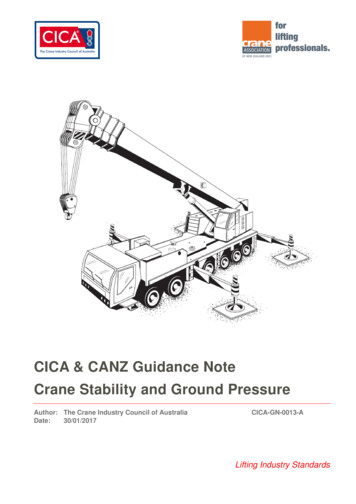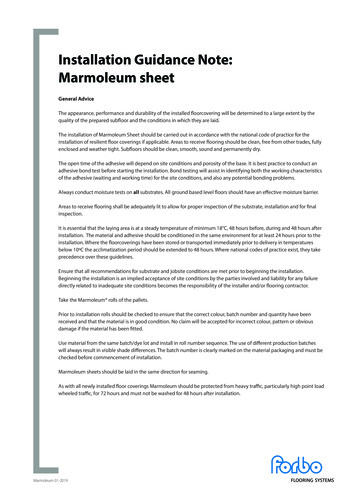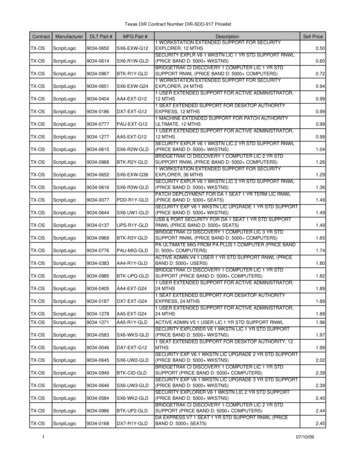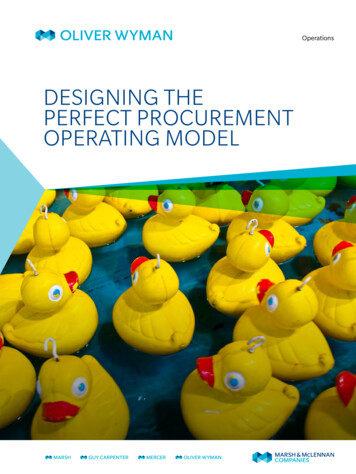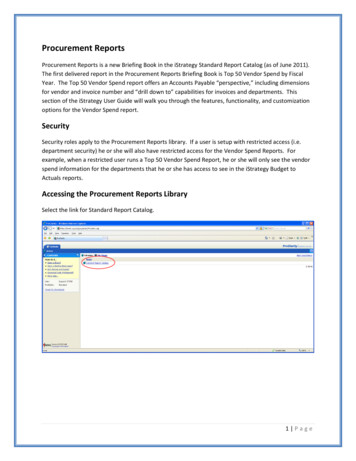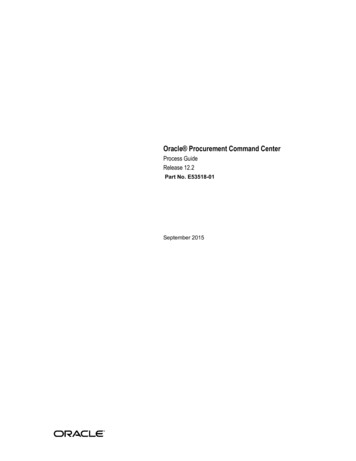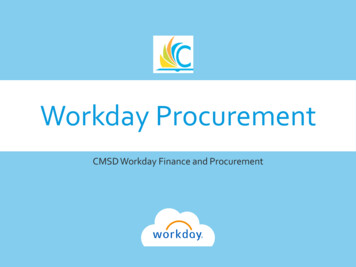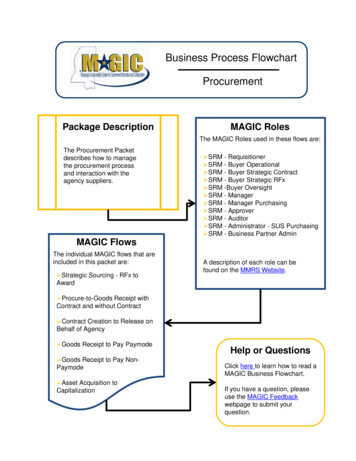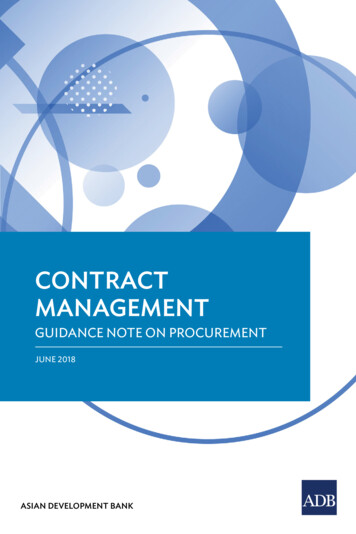
Transcription
CONTRACTMANAGEMENTGUIDANCE NOTE ON PROCUREMENTJUNE 2018ASIAN DEVELOPMENT BANK
CONTRACTMANAGEMENTGUIDANCE NOTE ON PROCUREMENTJUNE 2018ASIAN DEVELOPMENT BANK
Creative Commons Attribution-NonCommercial-NoDerivs 3.0IGO license (CC BY-NC-ND 3.0 IGO) 2018 Asian Development Bank6 ADB Avenue, Mandaluyong City, 1550 Metro Manila, PhilippinesTel 63 2 632 4444; Fax 63 2 636 2444www.adb.orgSome rights reserved. Published in 2018.ISBN 978-92-9261-182-8 (print), 978-92-9261-183-5 (electronic)Publication Stock No. TIM189231-2DOI: http://dx.doi.org/10.22617/TIM189231-2The views expressed in this publication are those of the authors and do not necessarily reflectthe views and policies of the Asian Development Bank (ADB) or its Board of Governors orthe governments they represent.ADB does not guarantee the accuracy of the data included in this publication and accepts noresponsibility for any consequence of their use. The mention of specific companies or productsof manufacturers does not imply that they are endorsed or recommended by ADB in preferenceto others of a similar nature that are not mentioned.By making any designation of or reference to a particular territory or geographic area, or by usingthe term “country” in this document, ADB does not intend to make any judgments as to the legalor other status of any territory or area.This work is available under the Creative Commons Attribution-NonCommercial-NoDerivs 3.0IGO license (CC BY-NC-ND 3.0 IGO) go/.By using the content of this publication, you agree to be bound by the terms of this license.For attribution and permissions, please read the provisions and terms of use athttps://www.adb.org/terms-use#openaccess.This CC license does not apply to non-ADB copyright materials in this publication. If the materialis attributed to another source, please contact the copyright owner or publisher of that sourcefor permission to reproduce it. ADB cannot be held liable for any claims that arise as a resultof your use of the material.Please contact pubsmarketing@adb.org if you have questions or comments with respect tocontent, or if you wish to obtain copyright permission for your intended use that does not fallwithin these terms, or for permission to use the ADB logo.Notes:In this publication, “ ” refers to United States dollars.Corrigenda to ADB publications may be found at http://www.adb.org/publications/corrigenda.Printed on recycled paper
ContentsTables, Figures, and Boxes ivAbout This Publication vAbbreviations viiiExecutive Summary ixI.Introduction 1II.Objective and Benefits of Contract Management 3III. The Contract Management Process 4IV. Reporting to and Requesting No-Objection from ADB 17V.18Resources for Further Review Appendix 1: Typical Contract Management Issues 19Appendix 2: Example of a Risk Management Plan 21Appendix 3: Example of a Contractor Performance Management System 23Appendix 4: Example of Contract Management Plan Templates 26
ivTables, Figures, and BoxesTABLESA3.Example of a Contractor Performance Management System 23A4.1. Example of Key Contacts List 26A4.2. Example of Communication Procedures 27FIGURES1.Contract Management within the ADB Procurement Cycle 22.Benefits of Good Contract Management 33.The Borrower’s Contract Management Process 44.Balancing the Focus of Performance Review Meetings 13A4.1. Example of Payment Procedure Flowchart 28A4.2. Example of a Contractual Work Program from an ADB-Financed Project 30Boxes1.Example of Contract Risk Allocation 62.Example of Employer’s Risk Management 63. Common Records to Be Maintained through Records Management 114.17Summary of Borrower’s Responsibilities
vAbout this PublicationIn April 2017, the Asian Development Bank (ADB) approved its new procurementframework, the ADB Procurement Policy: Goods, Works, Nonconsulting andConsulting Services (2017, as amended from time to time); and the ProcurementRegulations for ADB Borrowers: Goods, Works, Nonconsulting and ConsultingServices (2017, as amended from time to time). These replace the former Guidelineson the Use of Consultants (2013, as amended from time to time) and ProcurementGuidelines (2015, as amended from time to time). The procurement policy and theprocurement regulations address the procurement activities of project executingagencies and implementing agencies on projects financed in whole or in part by aloan or grant from ADB, or by ADB-administered funds. ADB designed the 2017procurement policy to deliver significant benefits and flexibility throughout theproject procurement cycle, as well as to improve project delivery through a renewedfocus on the concepts of quality, value for money (VFM), and fitness for purpose.This note is part of a series of guidance notes published by ADB in 2018 toaccompany the 2017 procurement policy and the procurement regulations.Each note discusses a topical issue for borrowers (including grant recipients),bidders, and civil society under the new framework (see list below). The guidancenotes cross-reference each other frequently and should be read in conjunction.All references to “guidance notes” pertain to these notes. The notes may beupdated, replaced, or withdrawn from time to time.List of Guidance Notes for the 2017 ADB ProcurementPolicy and the Procurement Regulations1.2.3.4.5.6.7.8.9.10.11.12.Value for MoneyProcurement Risk FrameworkStrategic Procurement PlanningProcurement ReviewAlternative Procurement ArrangementsOpen Competitive BiddingPrice AdjustmentAbnormally Low BidsDomestic PreferencePrequalificationSubcontractingConsulting Services Administeredby ADB Borrowers13. Nonconsulting Services Administeredby ADB Borrowers14. High-Level Technology15. Quality16. Bidding-Related Complaints17. Noncompliance in Procurement18. Standstill Period19. State-Owned Enterprises20. E-Procurement21. Framework Agreements forConsulting Services22. Public–Private Partnerships23. Contract Management24. Fragile, Conflict-Affected,and Emergency Situations
viAbout This PublicationADB procurement reforms intend to ensure VFM by improving flexibility, quality,and efficiency throughout the procurement cycle (see illustration below and theGuidance Note on Value for Money). VFM is part of a holistic procurement structurewith three support pillars: efficiency, quality, and flexibility. The two key principles oftransparency and fairness weave across all elements of the structure.Tra n s p a re n c yValue for MoneyThe effective, efficient, and economic use of resources,which requires an evaluation of relevant costs and benefits alongwith an assessment of risks, nonprice attributes, and/or total costof ownership as appropriateEfficiencyQualityFlexibility Decreased transactioncosts Increased skills Increased high-leveltechnology usage Improvedprocurement planning Support andencouragementof e-procurementsystems Contract managementsupport Prompt resolution ofcomplaints Improved developingmember countryprocurement process Improvedprocurement planning Governance Contracts with clearperformance criteria Minimal number ofcomplaints Improved ADBprocesses Open competitivebidding Decentralization Accreditationfor alternativeprocurementarrangements Principles-baseddecisions Improvedprocurement planning Delegation Bids with weightedproposalcriteriaFairnessTimeTime is an important element of VFM. When a project is delivered promptly or when aprocess is completed rapidly, greater value is created for all stakeholders. For example, aroad project completed early provides economic benefit, security, or other value to thecommunity it serves. It increases the return on investment to the executing agency andaccelerates the project and payment cycle to the successful bidder. Likewise, a projectdelivered late loses significant value.When considering VFM in the context of procurement, pay attention to anythingthat (i) shortens the procurement cycle time frame, or (ii) accelerates delivery of thedevelopment project.
About This PublicationObjectiveThis guidance note is intended to assist readers by elaborating on and explainingADB’s 2017 procurement policy and procurement regulations for borrowers(including grant recipients).This note identifies additional information for the reader to consider when applying ADB’sprocurement policy and procurement regulations to their circumstances.Living DocumentThis guidance note is intended to be a living document and will be revised as required.Be sure to check the ADB Business Center website for the latest version and updates,https://www.adb.org/business/main.The ReaderIn many circumstances, readers are expected to use this guidance note in a manner uniqueto their needs. For consistency throughout the suite of guidance notes, the followingassumption is made about the reader:The reader is a professional involved in activities financed in whole or in part by an ADB loanor grant, or by ADB-administered funds.FAQsFrequently asked questions, clarifications, examples, additional information, links to training,and other useful resources will be made available on the ADB website.Be sure to check the ADB Business Center website for more l and Order of PriorityThis guidance note explains and elaborates on the provisions of the ProcurementRegulations for ADB Borrowers: Goods, Works, Nonconsulting and Consulting Services(2017, as amended from time to time) applicable to executing (and implementing) agenciesunder sovereign (including subsovereign) projects financed in whole or in part by aninvestment loan from ADB (i.e., excluding ADB results- or policy-based loans),ADB-financed grant (excluding ADB-administered technical assistance and staffconsultancies), or by ADB-administered funds.In the event of any discrepancy between this guidance note and the procurementregulations, the latter will prevail. The financing agreement governs the legal relationshipsbetween the borrower and ADB. The rights and obligations between the borrower and theprovider of goods, works, or services are governed by the specific procurement documentissued by the borrower and by the contract signed between the borrower and the provider,and not by this guidance note.vii
viiiAbbreviationsADB—Asian Development BankCMP—contract management planKPI—key performance indicatorVFM—value for money
ixExecutive SummaryThis guidance note distinguishes between the work that is required precontract(upstream) and postcontract award (downstream), with focus on managingdownstream activities. Recognizing the need to deliver value for money, this noteemphasizes demonstrating the benefits of good contract management and howthis may be applied in projects financed in whole or in part by an ADB loan orgrant, or by ADB-administered funds. Contract management comprises all stagesand activities aimed at the overall goal of ensuring optional contract outcomes,including precontract award planning, contract administration and implementation,and contract closure.Good contract management mayIncrease Efficiency Prepare, from the onset, a contract management plan and mobilize therelevant resources for it.Support ongoing monitoring of a contractor’s performance.Operate a robust contract administration system, and maintain a reliablerecord management system.Reduce Risk Anticipate what could go wrong, e.g., payment delays, right of access to site.Put in place mitigation measures to address any identified risks.Manage the closure of the project, ensuring that no pending issues orobligations remain unaddressed.Deliver Value for Money Contractor meets the requirements of the project.Projects are completed on time or earlier.Applicable legislation is complied with.
I. Introduction1.1The Asian Development Bank’s (ADB’s) Procurement Regulations forADB Borrowers: Goods, Works, Nonconsulting and Consulting Services (2017,as amended from time to time) recognize that one factor contributing to achievingvalue for money (VFM) is effective contract management. Contract managementensures that supplier, contractor, and/or consultant deliverables are met as agreedunder the contract.1.2Contract management is the monitoring and control of contractorperformance to ensure optimal outcomes from a contract. It includes establishingcommunication pathways and protocols, monitoring progress toward deliveryof contract deliverables, managing payments, controlling variations, measuringcontractor performance, and closing out the contract.1.3This guidance note provides operational level guidance for borrowers(including grant recipients), through their executing and implementing agencies,on how contract management should be applied in projects following the awardof a contract financed in whole or in part by an ADB loan or grant, or by ADBadministered funds, for the procurement of goods, works, and services.11.4This guidance note assists users with contract management in theprocurement cycle. The activities relating to the borrower’s contract managementcommence at the contract formation stage and continue through to contractclosure, to ensure that contract obligations are met and deliver VFM. Figure1 illustrates where the contract management process occurs in the ADBprocurement cycle.1.5This guidance note applies to contracts financed in whole or in part byan ADB loan or grant, or by ADB-administered funds, for the procurement ofgoods, works, or services, including consulting services, to which the procurementregulations apply.212Borrowers, through their executing agencies, and any other party to a financing agreement shallalways act in accordance with the highest standard of ethics during any procurement process(including contract management) subject to the procurement regulations and any use of funds,resources, assets, and authority by such parties shall be in accordance with ADB’s AnticorruptionGuidelines (1998, as amended to date) and Integrity Principles and Guidelines (2015, asam
contractor performance, and closing out the contract. 1.3 This guidance note provides operational level guidance for borrowers (including grant recipients), through their executing and implementing agencies, on how contract management should be applied in projects following the award of a contract financed in whole or in part by an ADB loan or grant, or by ADB- Contract Management .



